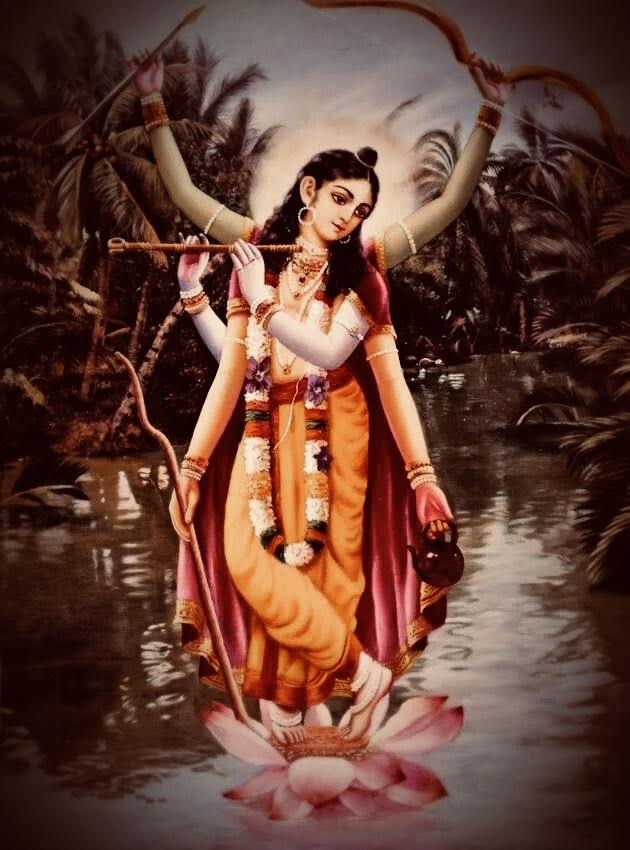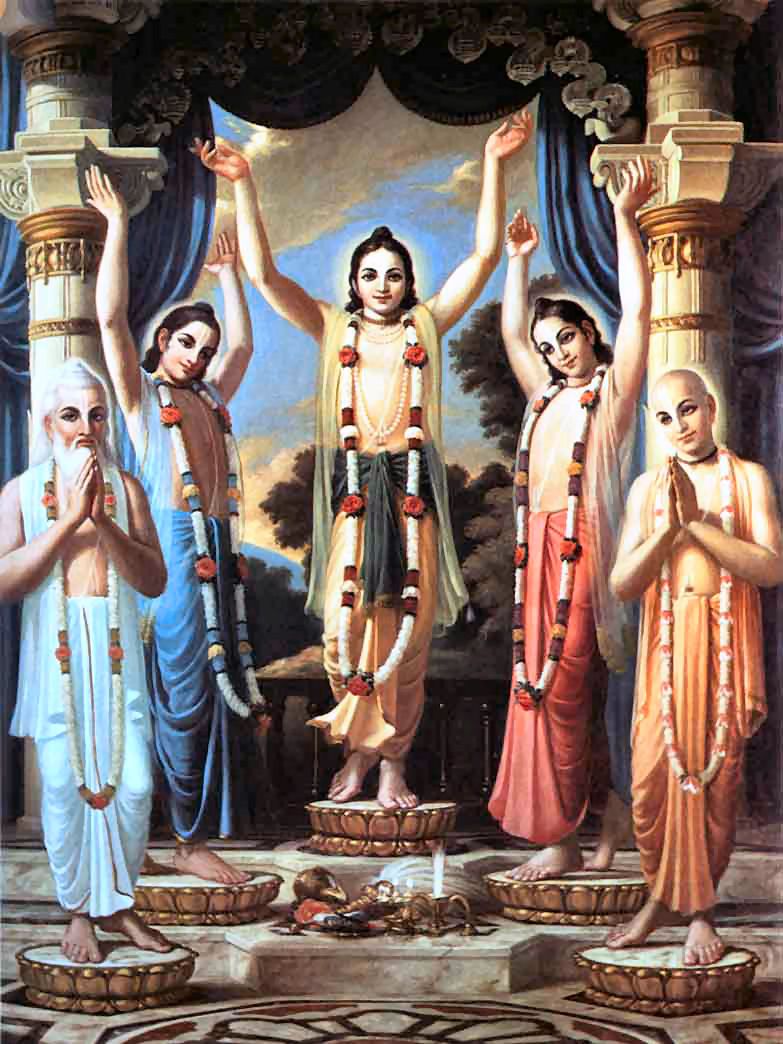When the Renaissance movement began in Europe in the 15th Century, on the other side of the globe, a very confidential avatar of Krishna appeared in India: Sri Lord Caitanya. Many scholars have declared that it is not coincidental the enlightenment period began with the re-apearance of Lord Krishna. It is also understood that Lord Caitanya’s appearance is very rare within the universe; Lord Caitanya in His “original” form appear “once” during the “day-time” in one of the 1000 Maha yugas which is the same ”time” as 1000 Maha yugas (4 billion 320 million years) according to the Brahma Samhita- which is 8,640,000,000 human years. The Vedas say that in the spiritual world every word is a song, every movement is a dance. In this very confidential and esoteric advent of Krishna we understand that He wonders how much transcendental pleasure is within Himself, and in order to taste His own potency, He sometimes takes the position of tasting Himself. From the historical records about Lord Chaitanya, we certainly see a picture of a God-conscious saint who appeared to gift the planet the most confidential maha mantra. But we have to seek further—into the devotional Vedic literature—to understand the full, spiritual significance of Lord Chaitanya and the bhakti movement that He inaugurated. We should consult the biographies of Lord Chaitanya, especially the Chaitanya-bhagavata, by Vrindavana dasa Thakura, and the Chaitanya-charitamrita, by Krishnadasa Kaviraja. Both of these works were compiled in the sixteenth century and are filled with first-hand accounts of Lord Chaitanya’s acts and teachings. They also give us an accurate picture of the social and religious setting in which Lord Chaitanya lived. The Chaitanya-charitamrita is especially valuable, because the author quotes extensively from the Sanskrit Vedic scriptures to authoritatively and logically establish the divinity of Lord Chaitanya. One of the opening verses of Chaitanya-charitamrita boldly asserts that Lord Chaitanya is none other than the Supreme Personality of Godhead, Lord Krishna Himself: What the Upanishads describe as the impersonal Brahman is but the effulgence of His body, and the Lord known as the Supersoul (Paramatma) is but His localized plenary portion. He is the Supreme Personality of Godhead, Krishna Himself, full with six opulences [wealth, fame, strength, beauty, knowledge, and renunciation]. He is the Absolute Truth, and no other truth is greater than or equal to Him. The author of Chaitanya-charitamrita does not expect us to accept this statement without proof; therefore, he carefully argues on the basis of guru, shastra, and sadhu to support his assertion about Lord Chaitanya. (According to Vedic knowledge. spiritual truth is revealed through three harmonious sources: the scriptures [shastra], the disciplic succession of previous saints and teachers [sadhu], and one’s own spiritual master [guru]. When these three authorized sources agree, then information is conclusive.) The verse I have quoted from Chaitanya-charitamrita, which asserts that Lord Chaitanya is the Supreme Lord, contains two important Sanskrit terms. Brahman and Paramatma. According to the Srimad-Bhagavatam, the Absolute Truth is manifest in three features. The impersonal feature is called Brahman, or the formless, eternal existence beyond the dualities of this temporary world. Brahman is the highest truth for the speculative, Vedanta philosophers and for certain mystic yogis. Paramatma refers to the Supersoul, the personal form of God as He appears in the heart of every living being. This expansion of God grants liberation from birth and death to those highly elevated yogis rapt in meditation on Him. The third feature of the Absolute described in Vedic literature is Bhagavan, or the original, personal form of Godhead as He eternally exists in His own spiritual abode. This form of the Absolute is the cause of both Brahman and Paramatma and is the highest truth of eternity, bliss, and knowledge. Bhagavan, or the Personality of Godhead, can be realized, however, not by philosophy or good works or yoga, but only by pure devotion. The conception of Bhagavan is the pure monotheistic idea described (though not very clearly) in Biblical references to the loving, all-powerful, all-knowing Father in heaven, the creator. In other words, God is more than an eternal force or law. Ultimately He is a loving person, and the goal of human life is to know Him, serve and love Him, and attain to eternal lifein His blissful spiritual kingdom. According to Vedic literature, Bhagavan, or the Personality of Godhead, appears in this world in various incarnations foretold in the scriptures. The Srimad-Bhagavatam gives a comprehensive list of the prominent incarnations and then concludes: ete camsha-kala pumsah krishnas tu bhagavan svayam. This means that all of the listed incarnations are parts of the Godhead , but the appearance of Lord Krishna is special because Krishna is bhagavan svayam, the original Personality of Godhead from whom all incarnations emanate. This is the conclusion of all the Vedic literatures—the Upanishads, the Puranas, and the Mahabharata and Bhagavad-gita. In the Gita Arjuna refers to the great authorities who accept Lord Krishna as the Supreme: “You are the Supreme Personality of Godhead, the ultimate abode, the purest, the Absolute Truth. You are the eternal, transcendental, original person, the unborn, the greatest. All the great sages such as Narada, Asita, Devala, and Vyasa confirm the truth about You, and now You Yourself are declaring it to me.”

